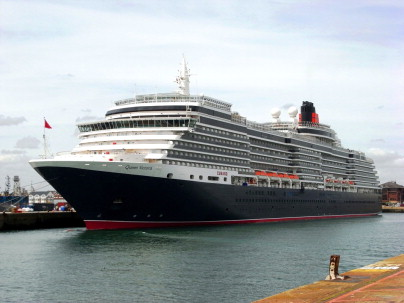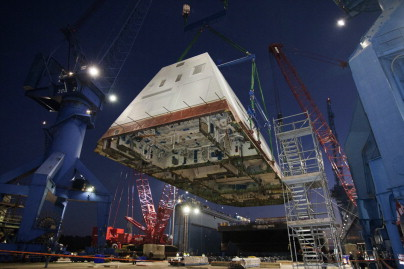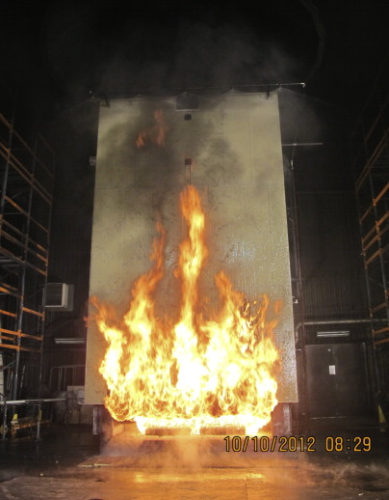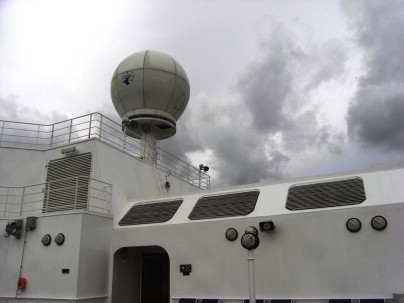



Fiber reinforced polymer (FRP) composites have been an accepted material in boatbuilding and motorsport for over 60 years. Com-posites make up more than half the structural airframes of modern commercial aircraft, such as the Airbus A350 XWB and the Boeing 787 Dreamliner. Their use is set to rocket in mainstream automo-tive as rapid manufacturing technologies are developed. FRP applications in construction and infrastructure are growing since early FRP bridges were installed twenty years ago. The weight reduction achievable with composites is enabling applications which would not be possible with metals, such as longer wind turbine blades and deeper risers for oil wells.
So why not composites in ships?
While small leisure and workboats are predominantly made in composites and there is increasing use of composites in naval vessels, the regulations for larger commercial vessels either severe-ly restrict or completely prohibit the structural use of composites. These regulations are based on or refer back to the International Maritime Organization (IMO) SOLAS (Safety of Life at Sea) regula-tions (see Marine vessel regulations explained). The restrictions come down to combustibility. SOLAS requires structural materials to be non-combustible and that has filtered through to several other European and national regulations. The ‘P’ in FRP is for polymer, and no organic polymer will pass the non-combustibility test (ISO 1182), so that rules out FRP composites. An amendment to the fire safety chapter of SOLAS in 2002 known as Regulation 17 allows for alternative design and arrangements to the prescriptive requirements. In theory this amendment could allow alternative materials to be used if equivalent safety can be demonstrated. But despite extensive R&D projects and product development, no structural FRP solution has yet been built for a commercial ship.
Why? Because the industry uses steel. Full stop. Shipping is highly risk-averse, for good reasons – the oceans are dangerous places and ships are very expensive. Upfront costs of FRP are usually higher than steel and there is surprisingly little consider-ation of through life costs, though that is beginning to change. An experienced naval architect and composites expert commented to me: ‘The biggest problem is when the customer can’t get his initial build budget and his through life budget in the same place.’ The financial structures are often wrong. From the regulators’ perspective there seems to be considerable reluctance to be first to approve structural composites, perhaps because of a substantial lobby at IMO which resists change in this area.
However, an IMO Correspondence Group is currently work-ing to develop guidelines for the use of FRP in ship structures which will facilitate assessment of new designs following the Regulation 17 process. Why would you want to use composites in ships? The weight reduction we typically associate with replacing tradi-tional materials with composites has different implications for ships. Of course fuel saving is an advantage, but despite the fluctuating price of oil, the increase in payload gained by structural weight savings tends to be more attractive and have a shorter payback. Ships are limited to about 290 m length and 32 m beam if they are to be able to pass through the locks on the Panama Canal. Most ports would involve similar limits. So to increase capacity in cruise ships, the only way is up and the structural mass above the waterline increasingly affects the ship’s stability. Hence lighter structural materials allow for a bigger superstructure with greater capacity.
A Swedish research project, LASS-C, looked at replacing the superstructure of cruise ship Norwegian Gem in composite. The payback period for the extra structural cost if you took the fuel savings gained from the weight reduction was 5.9 years, but the payback from income from the extra cabins you could build for the same overall weight was 2.5 years. Likewise the payback on cargo ships is quicker if you consider the potential extra payload rather than the fuel savings. For naval ships, the flexibility of the plat-form, the potential for extra weaponry and increased speed are all attractions which can be gained through topside weight reduction as well as reduced fuel consumption or increased range.
Corrosion resistance is an obvious advantage of composites over steel in a marine environment. In addition, for military customers, the potential to incorporate smart functionality and reduce magnetic, radar and infra-red signatures is of interest. The improved thermal and acoustic insulation properties of FRP are significant in many applications, for example, cruise ship balconies where thermal bridging is a problem, cabin partitions where noise transfer must be minimized.
One very practical potential application is a hatch cover which has been developed by Oshima Shipyard. These bulk carrier hatch covers are 17 m by 8 m for each half and would weigh 36 tonnes in steel, but just 12 tonnes in GRP. Most of the top reasons for insurance claims for damage to cargo are related to hatch covers – problems with seals, corrosion, etc. The GRP covers would reduce many of these problems, and allow for smaller, electric motors and lighter craneage. The structural design by Norwegian consultant Ragnar Hansen has been given approval in principle by DNV-GL and is now seeking formal approval in relation to the fire risk assessment.
A huge problem in steel ships is corrosion in ballast tanks. The tanks are integral to the structure of the hull, so structural beams pass through them, creating complex surfaces that are very difficult to maintain. A fully composite structure could solve this problem, but to suggest a composite hull for a large ship is a big step from where we are now.
Composites are already used in commercial ships in several applications including: masts and radomes, bathroom modules, lockers, lifeboats, pipework. Complete composite valve and pipe-work systems are available which have a major benefit in terms of corrosion resistance for seawater cooling systems. Superstructures for several naval ships have been built in com-posites in recent years, including two Zumwalt class destroyers for the US Navy; the Steregushchy Class corvettes and a stealth frigate, Admiral Gorshkov, for the Russian Navy; two corvettes for the Indian Navy.
The Indian corvette superstructures were built by Kockums naval shipyard in Sweden and followed the fully composite Visby class corvettes ‘built of sandwich-construction carbon fiber rein-forced plastic (CFRP). The material provides high strength and rigidity, low weight, good shock resistance, low radar signature and low magnetic signature. The material dramatically reduces the structural weight (typically 50% of a conventional steel hull). This results in a higher payload carrying capability, higher speed or longer range.’
What’s the real issue with fire?
Fire is a very real hazard for ocean going ships. You cannot evacuate and have people stand in the car park while the fire is put out. If you are several days from port, the fire must be con-tained if major risk to life and property is to be avoided. Steel does not burn and stays stronger for longer in a fire than FRP, but it will ultimately collapse. After one hour of the ISO 834 standard fire temperature curve uninsulated steel would retain about 5% of its strength and stiffness. Also it readily conducts heat, contributing to the spread of the fire, so the use of steel is dependent on good insulation. While FRPs have inherent combustibility due to their organic content, available materials have improved significantly in the last 20–30 years, as have fire protection systems.
Several approaches have been developed to resist ignition and flame spread. However, composites lose strength at a lower temperature in a fire than steeldoes, though they can out-perform aluminium structures which are accepted due to their non-combustibility. The critical factor for structural composites in fire is often to resist the collapse which would occur as the heat deflection temperature of the polymer is progressively exceeded through the thickness of the structure. In contrast to metals, composites are excellent insulators, so resist the spread of fire by conduction through a structure. An engine room fire aboard the GRP Royal Navy minehunter HMS Ledbury in 1983 burnt for several hours with no damage to adjacent compartments and no requirement for boundary cooling. The insulating properties of the structural laminates were sufficient to prevent either structural collapse or burn through.
Composite panels are used for fire and blast protection on offshore oil rigs and have been engineered to provide two hours or more of protection against jet fire. Bruce McDonald at Lloyd’s Register represents the International Association of Classification Societies (IACS) on the IMO Correspondence Group. He said that a major reason why he wants to progress the area is because composites have made oil rigs safer places. McDonald added: ‘FRP is not for everything, but there are benefits there. The materials technology is advancing and the fire risk can be mitigated. It depends on the right material choices. Prescriptive requirements are crude but effective, but with the current level of knowledge we have the capability to evaluate alternatives. Prescriptive regulations are looking backwards. We need to look forwards.’
Are we getting closer?
While composite technologies are still rapidly growing and developing into new markets, they have reached a level of maturity, particularly in boatbuilding and aerospace. Issues such as durability and repair are now well attested. The current program to refit the Royal Navy’s Hunt class minehunters is a good example. Their 60 m GRP hulls built in the late 1970s and 80s remain in excellent condition with a life of in excess of 50 years expected. The IMO Correspondence Group developing guidelines for FRP in ships is making progress, though the outcome is unclear as there is reluctance amongst some members to allow Regulation 17 to be used to justify an alternative to the prescriptive non-combustibility requirement.
Philippe Noury of DNV-GL in Norway has been involved in research and in classification of marine composites for many years. Referring to the High Speed Craft (HSC) Code, he points out that ‘FRP composite high speed vessels have been operated for about 25 years and have a positive service experience with respect to fire safety. Indeed, there has not been any serious fire disaster or frequent fire incident for this segment. This proves that regula-tions work, that active and passive fire protection systems in place are efficient and reliable, and that the industry has plenty of solid practical experience and solutions ready to be used for large commercial ships. We are not starting from scratch. This adds to the lessons learned from the last 10 years of R&D on the use of FRP composites on large commercial ships.’
Tommy Hertzberg of SP Fire Research in Sweden is engaging with the European Commission’s interest in standardizing test and certification procedures for fire behaviour of composite materials on vessels. This could facilitate the use of composites in passenger vessels and inland waterway and short sea shipping. Hertzberg believes that the fire test requirements of the HSC Code could be adapted to cover short sea and inland waterway craft as the fire risk issues are comparable. Tommy Hertzberg is also the chair of E-LASS,3 a European network for lightweight structures at sea. As such he led a drive to encourage the national authorities to support the work of the IMO Correspondence Group in early 2014. The E-LASS letter was supported by 85 organizations from across the world, indicating the strong interest in opening up a way to see the benefits of FRP. Perhaps most influential in pulling through change are the shipowners and shipbuilders. As they see the economic benefits of using composites, which tend also to translate to environmental benefits, regulators will have to ensure that the systems are in place to assess the safe use of composites.
Mike Collier of Carnival presented to national representatives at the IMO Maritime Safety Committee in November 2014, expressing that Carnival, the world’s largest cruise ship operator, is very keen to see the development of lightweight materials, particularly to reduce the weight of cabins and their contents. The interest shown by Oshima in developing the hatch cover is important, as is involvement in composite research projects of several European shipyards, including Meyer Werft and Fincantieri.
Marine vessel regulations explained
The IMO
The IMO is an agency of the United Nations responsible for “safe, secure and efficient shipping on clean oceans”. It has 170 member states and involves 63 intergovernmental organizations with observer status (such as the European Commission) as well as many NGO's with consultative status (such as the Community of European Shipyards’ Associations (CESA), International Association of Classification Societies (IACS)).
The IMO develops and adopts legislation, which is implemented by the flag states (government agencies such as UK's Maritime and Coastguard Agency, MCA). The flag state may “entrust the inspections and surveys either to surveyors nominated for the purpose or to organizations recognized by it” (SOLAS Chapter 1, regulation 6). In practice these “recognized organizations” are often classification societies, such as Lloyd's Register, DNV-GL.2
Commercial ships (International)
The IMO International Convention for the Safety of Life at Sea (SOLAS) is an international treaty originally adopted in 1914 in response to the Titanic disaster, but amended many times since. It specifies minimum standards for the safe construction, equipment and operation of passenger ships which carry more than 12 passengers or cargo ships of 300 gross tonnage and upwards and operate in international waters.
Chapter II-2 on fire protection requires structural materials to be non-combustible. This would prohibit any composite with an organic polymer matrix. However, a regulation which came into force in 2002, Chapter II-2/17 for alternative design and arrangements (Regulation 17) allows for alternatives to the prescriptive requirements using a risk based design approach to demonstrate equivalent safety.
Regulation 17 has been successfully used for some departures from the prescriptive code in other respects. Several projects have applied it for structural FRP, but it has not yet been accepted for any FRP (or other combustible structural material) application.
For this reason the IMO sub-committee on Ship Design and Construction (SDC) has a Correspondence Group developing guidelines for the use of FRP in structures on SOLAS vessels. This is a long and slow process and there remains a strong lobby of opinion in the SDC that the prescriptive (non-combustibility) requirements of SOLAS Chapter II must be adhered to, despite the intention of the 2002 amendment to allow for alternatives.
High speed craft code (International)
The International Code of Safety for High Speed Craft (HSC Code) has been in place since 1994, and allows for the use of composites in vessels capable of a certain speed (defined by an equation related to displacement). The code defines stringent but achievable fire tests and many vessels have been built to this code.
Passenger ships/ferries (EU)
Passenger ships/ferries operating in domestic (national) sea areas of the European Union (EU) are designed to Directive 2009/45/EC. This directive makes no allowance for structural FRP, requiring materials to be of “steel or another equivalent non-combustible material”.
EU Directives cover vessels in European waters, and are often followed but not mandatory for vessels which sail only in one flag state's national waters. Some flag states (such as Sweden, Denmark and Turkey) have allowed ferries to be built using structural FRP according to the HSC Code, though they do not meet the speed requirement, where they are operated within their own coastal waters.
Inland waterway vessels (EU)
Vessels operating on Inland waterways in the EU are covered by 2006/87/EC. This allows for alternative materials for hulls, and “steel or another equivalent material” for bulkheads, walls and decks, except in high fire risk areas (e.g. engine rooms) where structural materials must be non-combustible.
Large yachts (specific to national authorities)
Large yacht codes exist which allow for the use of structural composites for leisure yachts which carry up to 12 passengers and are 24 m and over in load line length. (e.g. UK's LY3) The fire requirements are not necessarily comparable to those in the HSC code.
In 2010 the Red Ensign Group (UK with Crown Dependencies and UK Overseas Territories) developed a Passenger Yacht Code (PYC, now 4th edition 2014) for leisure yachts which carry 13–36 passengers as an “equivalent arrangement” under SOLAS. At present this makes no allowance for structural FRP, requiring structural materials to be non-combustible.
Small leisure and workboats (EU)
These are covered respectively by the Recreational Craft Directive (RCD, 94/25/EC as amended by 2003/44/EC, soon to be replaced by 2013/53/EU) and Small Commercial Vessel Codes of Practice such as the UK's recently updated Brown Code (2014). These allow for the use of composites as long as they carry less than 12 passengers. In some cases, for workboats, special service personnel can be counted.





